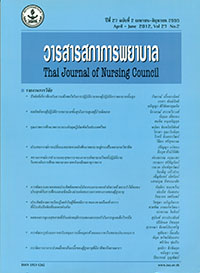ประสิทธิภาพการเรียนรู้จดจำาในผู้ที่เคยมีภาวะสมองขาดเลือดชั่วคราว ที่มีระดับปัจจัยเสี่ยงแตกต่างกัน
Keywords:
สมาธิ, ประสิทธิภาพการเรียนรู้จดจำ, ผู้ที่มีภาวะสมองขาดเลือดชั่วคราว, ปัจจัยเสี่ยง, attention, cognitive performance, transient ischemic attack, risk factorsAbstract
บทคัดย่อ
การวิจัยเชิงบรรยายจากการวิเคราะห์ข้อมูลทุติยภูมิของงานวิจัย เรื่อง ประสิทธิภาพ การเรียนรู้จดจำของผู้ที่เคยมีภาวะสมองขาดเลือดชั่วคราว (TIA) สมาธิ กระบวนการจำ การเรียนรู้ และการจำ โดยมีวัตถุประสงค์เพื่อศึกษาประสิทธิภาพการเรียนรู้และจดจำ ดังกล่าวในผู้ที่เคยมี สมองขาดเลือดชั่วคราว (TIA) ระหว่างกลุ่มที่มีปัจจัยเสี่ยงสูง ปานกลาง และต่ำต่อการเกิดโรคหลอดเลือดสมอง กลุ่มตัวอย่างได้จากการสุ่มแบบสะดวก จากหอผู้ป่วยนอก สถาบันประสาทวิทยา โรงพยาบาลราชวิถี โรงพยาบาลเลิดสินและโรงพยาบาลพระนครศรีอยุธยา จำนวน 52 คน เป็นกลุ่มที่มีปัจจัยเสี่ยงสูง 14 คน ปัจจัยเสี่ยงปานกลาง 28 คน และ ปัจจัยเสี่ยงต่ำ 10 คน เครื่องมือที่ใช้ในการเก็บรวบรวมข้อมูล ได้แก่ แบบทดสอบประสิทธิภาพการเรียนรู้และจดจำ ซึ่งประกอบด้วย 1) แบบวัดสมาธิ (Trial Making a Test และ Digital Span Forward Test) 2) แบบวัดกระบวนการจำ (Digital Symbol Substitution Test และ The Hopkins Verbal Learning Test 3) แบบวัดการเรียนรู้และการจำ (The Hopkins Verbal Test- revised ) การวิเคราะห์ข้อมูล ใช้สถิติการวิเคราะห์ความแปรปรวนแบบทางเดียว (One-way analysis of Variance)
ผลการวิจัย พบว่า กลุ่มที่เคยมีภาวะสมองขาดเลือดชั่วคราวที่มีปัจจัยเสี่ยงสูง ปานกลาง และต่ำ มีคะแนนเฉลี่ยของแบบวัดประสิทธิภาพการเรียนรู้จดจำทั้ง 3 ด้านหลัก แตกต่างกันอย่างมีนัยสำคัญทางสถิติ (p<0.05) โดยกลุ่มที่มีปัจจัยเสี่ยงต่ำ มีคะแนนเฉลี่ยของแบบวัดสมาธิ ด้านสมาธิในการฟังและการพูด (Digital Span Forward Test) กระบวนการจำและการเรียนรู้ จดจำสูงสุด รองลงมาเป็นกลุ่มที่มีปัจจัยเสี่ยงปานกลางและปัจจัยเสี่ยงสูงตามลำดับ ในขณะที่กลุ่ม ที่มีปัจจัยเสี่ยงต่ำมีคะแนนเฉลี่ยของแบบวัดสมาธิด้านความตั้งใจหรือการใช้สายตา (Trial Making A) ต่ำสุด ตามด้วยกลุ่มที่มีปัจจัยเสี่ยงปานกลางและสูงตามลำดับ ผลการศึกษาแสดงให้เห็นว่า กลุ่มที่เคยมีภาวะสมองขาดเลือดชั่วคราวที่มีปัจจัยเสี่ยงสูงมีประสิทธิภาพการเรียนรู้จดจำ ทั้ง 3 ด้าน หลักต่ำสุด ตามด้วยกลุ่มที่มีระดับคะแนนปัจจัยเสี่ยงปานกลางและต่ำตามลำ ดับ
พยาบาลและบุคลากรในทีมสุขภาพควรตระหนักถึงประสิทธิภาพในการรับข้อมูลด้านสุขภาพ โดยเฉพาะผู้ที่คะแนนปัจจัยเสี่ยงต่อภาวะสมองขาดเลือดชั่วคราวในระดับสูง โดยหาวิธีการที่เหมาะสมในส่งเสริมการเรียนรู้จดจำและการช่วยให้บุคคลในแต่ละกลุ่มสามารถรับข้อม สุขภาพได้อย่างมีประสิทธิภาพ
คำสำคัญ : สมาธิ, ประสิทธิภาพการเรียนรู้จดจำ, ผู้ที่มีภาวะสมองขาดเลือดชั่วคราว, ปัจจัยเสี่ยง
Abstract
This descriptive research was derived from secondary data analysis of the study of cognitive performance after a transient ischemic attack: attention, working memory, and learning and memory. This study aimed to explore this cognitive performance among three groups of TIA who had high, medium, and low risk factors to cerebrovascular disease. Convenient sampling was used to recruit 52 TIA from the outpatient departments of Prasart Neurological Institute, Rajavithi hospital, Lerdsin hospital, and Phra Nakhon Si Ayutthaya hospitals. There were 14 high, 28 medium, and 10 low risk factors of cerebrovascular disease. The instruments consisted of the Trial Making A Test, Digit Span Forward and Backward Test, Digit Symbol Substitution Test, and Hopkins Verbal Learning Test. One-Way Analysis of Variance (One-Way ANOVA) design was used to analyze the data.
The results showed that the groups which experienced TIA having high, medium, and low risk factors to cerebrovascular disease displayed a significant difference in all tests regarding the three main cognitive functions (P< 0.05). People in the low risk factor group displayed the highest mean scores of attention test which concentration abilities was mediated through auditory and verbal (Digit Span Forward test), working memory test, and learning and memory test, followed by people having medium, and high risk factors groups. In contrast, people in the low risk factor group had the lowest mean scores of attention test or concentration abilities involving visual-motor (Trial Making A Test) followed by people having medium and high risk factors to cerebrovascular disease. The findings indicate that individuals who had high risk factors of cerebrovascular showed the least ability in all three main cognitive functions, followed by people having risk factors to cerebrovascular diseases, and healthy people.
Thus, nurses and health care providers should concerned with the cognitive ability of TIA who have had a high score of risk factors to cerebrovascular diseases, so nurses and health care providers can apply appropriate strategies to provide proper health information for these two groups. Then they can receive effectiveness health information.
Keywords : attention, cognitive performance, transient ischemic attack, risk factors








